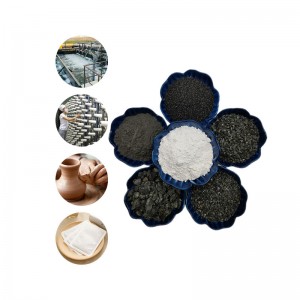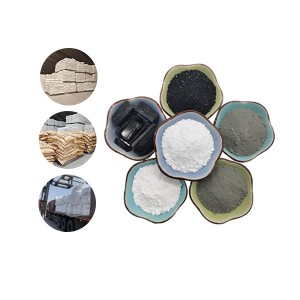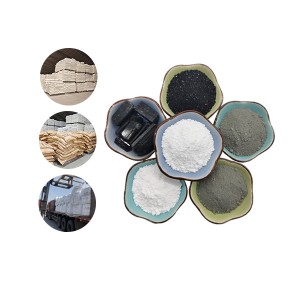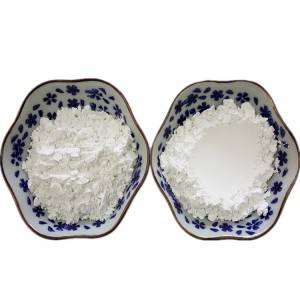-

Tourmaline powder for architectural materials ceramic glaze modification plastic reinforcement decorative stone enhancement thermal stability wear resistance surface coating
Tourmaline Powder emerges as versatile mineral material that bridges Sustainable Living and Circular Economy, adapting innovatively to diverse demands of Architectural Materials, Ceramic Glaze Modification, and Plastic Reinforcement. Unlike single-function mineral additives prone to performance gaps, Tourmaline Powder exhibits unique combination of physical traits—thermal stability, hardness, and dispersion ability—that enhance functionality of end products across industries. Derived from natural tourmaline ore deposits with varied mineral compositions (pink, green, black, colorless), Tourmaline Powder undergoes physical processing without toxic chemicals, aligning with modern trends focused on durability and resource efficiency. Serving as core component in Decorative Stone Enhancement and Surface Coating, Tourmaline Powder transcends single-role limits to become multi-purpose solution blending structural reinforcement, aesthetic optimization, and long-term durability.Resource foundation of Tourmaline Powder combines natural abundance and regional diversity, with ore traits tailored to specific application needs. Natural tourmaline ore exists in distinct geological formations worldwide, each yielding powder with unique properties: Brazilian pink tourmaline deposits produce powder with ultra-fine particle size and high thermal stability, ideal for Ceramic Glaze Modification requiring uniform dispersion; African green tourmaline ore yields powder with strong surface adhesion, perfect for Plastic Reinforcement needing tight bonding with polymer matrices; Sri Lankan black tourmaline deposits offer high-hardness powder suited for Decorative Stone Enhancement demanding wear resistance. Mining of tourmaline ore adheres to selective extraction methods—surface mining is prioritized to avoid deep geological disturbance, and ore sorting relies on physical screening (not chemical leaching) to separate tourmaline crystals from associated minerals like quartz and feldspar, preserving mineral integrity.Processing of Tourmaline Powder focuses on preserving inherent traits and optimizing compatibility with target applications. Ore processing begins with coarse crushing using low-energy jaw crushers to prevent particle damage, followed by fine grinding via airflow mills operating at moderate temperatures—this method retains tourmaline’s crystal structure, which is critical for thermal stability and hardness. Multi-stage air classification separates powder into precise particle size grades: ultra-fine powder (for Ceramic Glaze Modification, ensuring no visible particles in glazes); medium-grade powder (for Surface Coating, enabling smooth application); and coarse powder (for Plastic Reinforcement, providing structural support). No toxic chemicals or solvents are used throughout processing, maintaining non-toxic nature suitable for consumer and industrial products.Key processing step involves surface activation tailored to end uses: Tourmaline Powder for Plastic Reinforcement is treated with natural silicate compounds to enhance adhesion to polymer resins; powder for Ceramic Glaze Modification undergoes low-temperature calcination to reduce moisture content (preventing glaze bubbling); powder for Decorative Stone Enhancement is coated with plant-based waxes to improve dispersion in coating formulations. Waste generated during processing—mainly non-tourmaline mineral residues—is repurposed as aggregate in Architectural Materials (like concrete blocks), aligning with Circular Economy principles by minimizing landfill waste. Energy efficiency is prioritized via solar-powered drying systems and heat recovery from grinding processes, reducing overall carbon footprint.Core properties of Tourmaline Powder make it irreplaceable across target industries, with each trait directly addressing application challenges. Thermal stability allows Tourmaline Powder to retain structure at high temperatures—critical for Ceramic Glaze Modification, where it resists color shifting and glaze cracking during kiln firing. Hardness (exceeding that of many mineral additives) enhances wear resistance in Decorative Stone Enhancement, ensuring colored or coated stones maintain appearance in high-traffic areas. Dispersion ability enables uniform distribution in Plastic Reinforcement, preventing weak spots in polymer products. Surface reactivity promotes strong bonding with diverse substrates, from ceramic glazes to plastic resins, reducing risk of additive separation over time. Color neutrality of clear tourmaline powder preserves base hues in coatings and glazes, while colored variants (like green or pink) can add subtle tinting for custom aesthetics.Ceramic Glaze Modification stands as flagship application for Tourmaline Powder, where it solves common industry challenges. In residential tile production, ultra-fine pink tourmaline powder is added to transparent glazes to boost thermal shock resistance—tiles coated with these glazes withstand sudden temperature changes (like hot pots placed on kitchen tiles) without cracking. For decorative ceramic vases, green tourmaline powder is mixed into colored glazes to enhance color depth and gloss; its fine particle size eliminates streaking, creating smooth, uniform finishes. Industrial ceramic applications (like floor tiles for commercial spaces) use black tourmaline powder to reinforce glazes, doubling wear resistance compared to standard glazes and reducing replacement frequency.Plastic Reinforcement benefits significantly from Tourmaline Powder’s structural and functional traits. In outdoor plastic furniture, coarse black tourmaline powder is blended into polyethylene resins—this combination enhances UV resistance (preventing plastic fading) and increases impact strength, allowing furniture to withstand harsh weather and heavy use. For plastic packaging used in industrial parts, medium-grade tourmaline powder adds rigidity without sacrificing flexibility, reducing material usage while maintaining durability. Decorative plastic panels (used in interior design) integrate ultra-fine pink or green tourmaline powder to create subtle, marble-like textures; powder’s dispersion ability ensures consistent pattern across large panels, avoiding blotchiness common with other additives.Decorative Stone Enhancement leverages Tourmaline Powder’s aesthetic and protective properties. In natural marble renovation, medium-grade tourmaline powder is mixed into stone sealants to create protective Surface Coating—powder’s hardness forms barrier against scratches, while its transparency preserves marble’s natural veining. For artificial stone production, tourmaline powder is integrated into resin-stone mixtures: black tourmaline adds depth to granite-like artificial stones, while pink tourmaline creates rose-hued variants. These artificial stones require less maintenance than natural stone, as tourmaline’s weather resistance prevents color fading and surface degradation. In landscaping, tourmaline-powder coated river rocks retain vibrant colors for years, outperforming uncoated rocks that fade quickly in sunlight.Architectural Materials integrate Tourmaline Powder for both function and aesthetics. In concrete decorative blocks, coarse tourmaline powder is added to concrete mixtures to enhance strength and add subtle texture—blocks with tourmaline powder resist cracking better than standard concrete and hold paint longer. For drywall joint compounds, ultra-fine tourmaline powder improves workability and reduces shrinkage, ensuring smooth, long-lasting joints. Exterior stucco formulations use medium-grade tourmaline powder to boost weather resistance; stucco with tourmaline powder resists rain penetration and retains color, reducing repainting needs for residential and commercial buildings.Quality control of Tourmaline Powder is tailored to specific applications, ensuring consistent performance. For Ceramic Glaze Modification, tests include particle size analysis (via laser diffraction) to verify uniformity, thermal stability tests (exposing powder to firing temperatures to check structure retention), and glaze compatibility tests (mixing with glazes to ensure no bubbling or discoloration). For Plastic Reinforcement, tests measure tensile strength (verifying reinforcement effect), dispersion uniformity (inspecting plastic samples for additive clumps), and UV resistance (exposing samples to simulated sunlight to check color and strength retention).For Decorative Stone Enhancement, wear resistance tests use standardized abrasion machines to simulate foot traffic; adhesion tests measure bond strength between powder coatings and stone surfaces. For Architectural Materials, compression strength tests verify structural improvement, and weather resistance tests expose samples to rain, sunlight, and temperature cycles. All tourmaline powder batches undergo purity testing to ensure no harmful contaminants, and recycled powder waste (from production trimmings) undergoes magnetic separation to remove metal impurities before reuse in less demanding applications (like concrete aggregates).In conclusion, Tourmaline Powder stands as cornerstone mineral additive aligning with Sustainable Living and Circular Economy. Its natural origin, eco-friendly processing, and versatile properties—thermal stability, hardness, dispersion ability—drive unique value in Ceramic Glaze Modification, Plastic Reinforcement, Decorative Stone Enhancement, and Architectural Materials. Unlike synthetic additives that rely on toxic chemicals or have narrow application scopes, Tourmaline Powder enhances both functional and aesthetic traits of end products while minimizing environmental impact.Real-world applications demonstrate its adaptability: from durable ceramic tiles to weather-resistant plastic furniture, and from long-lasting decorative stone to strong architectural materials. As demand for multi-functional, long-lasting materials grows—fueled by consumer preference for low-maintenance products and industrial focus on waste reduction—Tourmaline Powder is poised to expand its market reach. Ongoing research into nano-sized Tourmaline Powder and advanced surface activation techniques promises even greater performance, such as enhanced transparency in glazes and improved reinforcement in biodegradable plastics. -

Tourmaline Powder Industrial Adsorbent for Waste Gas Treatment Remove Volatile Organic Compounds Odor Control High Adsorption Capacity
Industrial waste gas emissions—containing volatile organic compounds (VOCs) like benzene, toluene, and formaldehyde, as well as odorous substances like hydrogen sulfide—pose significant environmental and health risks. Traditional waste gas treatment methods, such as incineration and chemical scrubbing, are costly and generate secondary pollution, while activated carbon adsorbents have limited adsorption capacity and require frequent replacement. Tourmaline powder, a mineral adsorbent with high porosity and surface activity, addresses these challenges, providing an efficient, cost-effective solution for waste gas treatment in industries like chemical manufacturing, printing, and painting.The adsorption capacity of tourmaline powder for VOCs and odorous compounds is rooted in its unique surface properties. The powder features a network of micro- (2-5 nm) and mesopores (5-50 nm) that provide a large specific surface area (20-35 m²/g), allowing for extensive contact with waste gas molecules. Additionally, tourmaline’s surface has abundant hydroxyl groups (-OH) and electrostatic charge sites, which form strong physical and chemical bonds with VOCs and odorous compounds. For example, tourmaline powder adsorbs 150-200 mg/g of benzene (a common VOC) and 80-100 mg/g of hydrogen sulfide (an odorous gas), far exceeding the adsorption capacity of activated carbon (100-120 mg/g for benzene, 50-60 mg/g for hydrogen sulfide). This high capacity reduces the frequency of adsorbent replacement, cutting operational costs by 30-40% compared to activated carbon systems.VOC removal efficiency is a key performance metric for industrial waste gas treatment, and tourmaline powder delivers exceptional results. In a chemical plant treating benzene-containing waste gas (concentration 500-800 mg/m³), a tourmaline-based adsorption tower achieved a removal rate of 95-98%, reducing emissions to below 20 mg/m³ (meeting China’s GB 31571-2015 standard). For printing and painting facilities, which generate formaldehyde and toluene emissions, tourmaline powder removes 90-93% of these VOCs, eliminating the “paint smell” associated with these industries. The powder’s adsorption efficiency remains stable even at varying gas flow rates (1-3 m/s) and temperatures (20-80°C), making it suitable for diverse industrial environments.Odor control is another critical benefit of tourmaline powder in waste gas treatment. Odorous compounds like hydrogen sulfide (rotten egg smell) and ammonia (pungent smell) are often present in waste gas from food processing (non-food industry focus on packaging/manufacturing) and chemical plants. Tourmaline’s ability to adsorb these compounds not only reduces environmental pollution but also improves workplace air quality, reducing employee complaints and health risks. A Chinese chemical plant using tourmaline adsorbents reported a 90% reduction in odor complaints from nearby communities, as the powder reduced hydrogen sulfide emissions from 100 mg/m³ to <5 mg/m³. Additionally, tourmaline does not release adsorbed odors even when exposed to moderate temperature fluctuations, ensuring long-term odor control.Regenerability is a major advantage of tourmaline powder over traditional adsorbents. After adsorption saturation, the powder can be regenerated through thermal treatment (150-200°C) or steam stripping, which desorbs the adsorbed VOCs and odorous compounds. Unlike activated carbon, which loses 20-30% of its adsorption capacity after each regeneration cycle, tourmaline retains 85-90% of its initial capacity after 8-10 cycles. This extends the adsorbent’s lifespan from 3-6 months (activated carbon) to 12-18 months (tourmaline), significantly reducing waste and replacement costs. The desorbed VOCs can also be recovered and reused in industrial processes (e.g., benzene recovery in chemical plants), creating additional economic value.Chemical stability ensures tourmaline powder’s performance in harsh waste gas environments. It is resistant to acidic and alkaline gases (pH 2-12), making it suitable for treating waste gas from acid-based chemical processes (e.g., sulfuric acid production) and alkaline processes (e.g., ammonia synthesis). The powder does not dissolve or release heavy metals into the environment, meeting strict environmental standards like the EU’s Industrial Emissions Directive (IED) and the US EPA’s Clean Air Act. This stability also reduces the risk of adsorbent degradation, ensuring consistent performance over time.Compatibility with different waste gas treatment systems makes tourmaline powder versatile. It can be used in fixed-bed adsorption towers (for low-flow gas streams), fluidized-bed reactors (for high-flow streams), and membrane adsorption systems (for precise VOC removal). It can also be mixed with other adsorbents like zeolite to enhance specific performance—for example, combining tourmaline with zeolite improves ammonia removal efficiency by 10-15%. For small-scale facilities (e.g., small printing shops), tourmaline powder can be packed into portable adsorption units, providing a compact, low-cost treatment solution.Customization options cater to diverse industrial needs. Suppliers offer tourmaline powder with different pore structures: micro-pore-rich grades (for small-molecule VOCs like formaldehyde) and meso-pore-rich grades (for large-molecule VOCs like toluene). Fine grades (5-10 μm) are used in membrane systems to ensure uniform gas contact, while coarser grades (20-30 μm) are ideal for fixed-bed towers to prevent pressure drop. High-purity grades (95%+ tourmaline content) are suitable for sensitive industries like electronics manufacturing (low VOC requirements), while cost-effective grades (80-90% content) suit general industrial use.Practical application cases validate tourmaline powder’s value. A German printing facility replaced its activated carbon system with a tourmaline-based adsorption unit, reducing VOC emissions by 92% and cutting annual adsorbent costs by €30,000. A Chinese chemical plant using tourmaline adsorbents for hydrogen sulfide treatment extended adsorbent replacement intervals from 4 months to 16 months, reducing waste disposal costs by 75%. These cases demonstrate the economic and environmental benefits of tourmaline powder, making it a preferred choice for global industrial clients.For foreign trade merchants,promoting tourmaline powder as an industrial adsorbent requires emphasizing adsorption capacity, regenerability, and compliance with environmental standards. Providing test data from environmental labs (e.g., SGS, EPA-approved labs) verifying VOC removal rates and regeneration efficiency builds credibility. Highlighting cost savings from reduced replacement and waste disposal appeals to cost-conscious industrial facilities. Additionally, offering custom adsorption system design (e.g., tower size, powder loading) helps clients integrate the powder into their existing waste gas treatment processes.Logistics and compliance support are essential for international sales. Tourmaline powder should be packaged in sealed, dust-proof containers to prevent particle dispersion during shipping—25kg paper bags with inner PE liners are standard, while 1-ton bulk bags suit large industrial orders. Providing English-language TDS and SDS ensures compliance with import regulations (e.g., EU REACH, US EPA). Offering technical support, such as regeneration process guidance and adsorbent replacement schedules, enhances customer satisfaction and long-term partnerships.In summary, tourmaline powder’s high adsorption capacity, VOC removal efficiency, odor control, regenerability, and chemical stability make it a valuable industrial adsorbent for waste gas treatment. Its cost-effectiveness, compatibility with diverse systems, and proven application cases position it as an excellent product for foreign trade merchants targeting industries like chemical manufacturing, printing, and painting. By highlighting these advantages, businesses can effectively market tourmaline powder to global industrial clients seeking efficient, sustainable waste gas treatment solutions. -

Tourmaline powder for purifying water quality purifying air textile materials ceramic industry
The formation of tourmaline is closely related to specific geological processes. It often forms in pegmatite dikes, which are coarse – grained igneous rocks that crystallize from hydrothermal solutions rich in various elements. These solutions are typically associated with the late – stage crystallization of magma. For example, in regions with significant granite intrusions, the hydrothermal fluids carrying boron, aluminum, silicon, and other elements can interact with the surrounding rocks. Under the right conditions of temperature, pressure, and chemical composition, tourmaline crystals start to precipitate and grow.Another important environment for tourmaline formation is in high – temperature, high – pressure metamorphic rocks. When pre – existing rocks are subjected to intense heat and pressure, such as during mountain – building processes, the chemical components within the rocks can rearrange. Minerals like tourmaline can form as a result of the reaction between different rock – forming minerals in the presence of fluids containing boron.
-

In the industrial world natural black and white tourmaline powder’s unique properties find diverse applications
In the industrial realm, tourmaline powder plays a crucial role. Its unique electrical and thermal properties make it highly sought – after. For example, in the electronics industry, it can be used to enhance the performance of certain components. Due to its piezoelectric characteristics, tourmaline powder can convert mechanical stress into electrical energy, which is useful in sensors.In the ceramic industry, adding tourmaline powder can improve the strength and durability of ceramics. It also has applications in water treatment, as it may help in purifying water by interacting with impurities. Its versatility makes it an essential ingredient in various industrial processes.
-

Huabang Tourmaline powder rough black white nano tourmaline powder superfine release far infrared
Far infrared ceramic powder can radiate more far infrared rays (higher infrared emissivity) than normal objects. In the high temperature area, it is mainly used for heating the boiler, baking the paint, heating and drying the wood and food, etc.; in the normal temperature area, it is mainly used for manufacturing various far-infrared thermal insulation materials, such as far-infrared ceramic powder, far-infrared ceramic fiber, far-infrared ceramic polyester, and far-infrared functional ceramics, etc. Far infrared ceramic coating (including nano titanium oxide coating) has catalytic oxidation function.
Our type: far-infrared powder, ion negative powder, white tourmaline powder.
Function: ion negative, far-infrared so on.
-

Huabang Tourmaline powder rough black white nano tourmaline powder superfine release for paint for healthy
Far infrared ceramic powder can radiate more far infrared rays (higher infrared emissivity) than normal objects. In the high temperature area, it is mainly used for heating the boiler, baking the paint, heating and drying the wood and food, etc.; in the normal temperature area, it is mainly used for manufacturing various far-infrared thermal insulation materials, such as far-infrared ceramic powder, far-infrared ceramic fiber, far-infrared ceramic polyester, and far-infrared functional ceramics, etc. Far infrared ceramic coating (including nano titanium oxide coating) has catalytic oxidation function.
Our type: far-infrared powder, ion negative powder, white tourmaline powder.
Function: ion negative, far-infrared so on.
-

Tourmaline powder rough black nano tourmaline powder superfine release far infrared
Far infrared ceramic powder can radiate more far infrared rays (higher infrared emissivity) than normal objects. In the high temperature area, it is mainly used for heating the boiler, baking the paint, heating and drying the wood and food, etc.; in the normal temperature area, it is mainly used for manufacturing various far-infrared thermal insulation materials, such as far-infrared ceramic powder, far-infrared ceramic fiber, far-infrared ceramic polyester, and far-infrared functional ceramics, etc. Far infrared ceramic coating (including nano titanium oxide coating) has catalytic oxidation function.
Our type: far-infrared powder, ion negative powder, white tourmaline powder.
Function: ion negative, far-infrared so on.
-

Tourmaline powder rough black nano tourmaline powder superfine release far infrared
Far infrared ceramic powder can radiate more far infrared rays (higher infrared emissivity) than normal objects. In the high temperature area, it is mainly used for heating the boiler, baking the paint, heating and drying the wood and food, etc.; in the normal temperature area, it is mainly used for manufacturing various far-infrared thermal insulation materials, such as far-infrared ceramic powder, far-infrared ceramic fiber, far-infrared ceramic polyester, and far-infrared functional ceramics, etc. Far infrared ceramic coating (including nano titanium oxide coating) has catalytic oxidation function.
Our type: far-infrared powder, ion negative powder, white tourmaline powder.
Function: ion negative, far-infrared so on.
-

Tourmaline powder, white tourmaline powder nano. black tourmaline stone for sale
Far infrared ceramic powder can radiate more far infrared rays (higher infrared emissivity) than normal objects. In the high temperature area, it is mainly used for heating the boiler, baking the paint, heating and drying the wood and food, etc.; in the normal temperature area, it is mainly used for manufacturing various far-infrared thermal insulation materials, such as far-infrared ceramic powder, far-infrared ceramic fiber, far-infrared ceramic polyester, and far-infrared functional ceramics, etc. Far infrared ceramic coating (including nano titanium oxide coating) has catalytic oxidation function.
-

Natural Black Tourmaline Rough Stone Black Tourmaline Raw Large Black Tourmaline for Sale
Black tourmaline can produce far-infrared wave band, producting negative oxygen ions, and it has antibacterial and deodorizing effect. containing many indispensable trace elements in the body, such as copper, zinc, iron and so on.So it can be widely used in water purification, decoration, clothing, paint, cosmetics, etc.
We can offer: 1. 7*24 hours service. 2. technical support, 3. quality control. 4. custom service.
-

Black/White Tourmaline Powder Price High Pure Health Products Manufacturer Black Tourmaline Powder
Far infrared ceramic powder can radiate more far infrared rays (higher infrared emissivity) than normal objects. In the high temperature area, it is mainly used for heating the boiler, baking the paint, heating and drying the wood and food, etc.; in the normal temperature area, it is mainly used for manufacturing various far-infrared thermal insulation materials, such as far-infrared ceramic powder, far-infrared ceramic fiber, far-infrared ceramic polyester, and far-infrared functional ceramics, etc. Far infrared ceramic coating (including nano titanium oxide coating) has catalytic oxidation function.
-

Tourmaline Rough
Application
1. High pure tourmaline is the bijou that can be made into jewelry such as necklace bracelet and so on.
2. Purification materials for water and air.
3. Tourmaline can be used in agriculture to shorten the growing period of crops.


